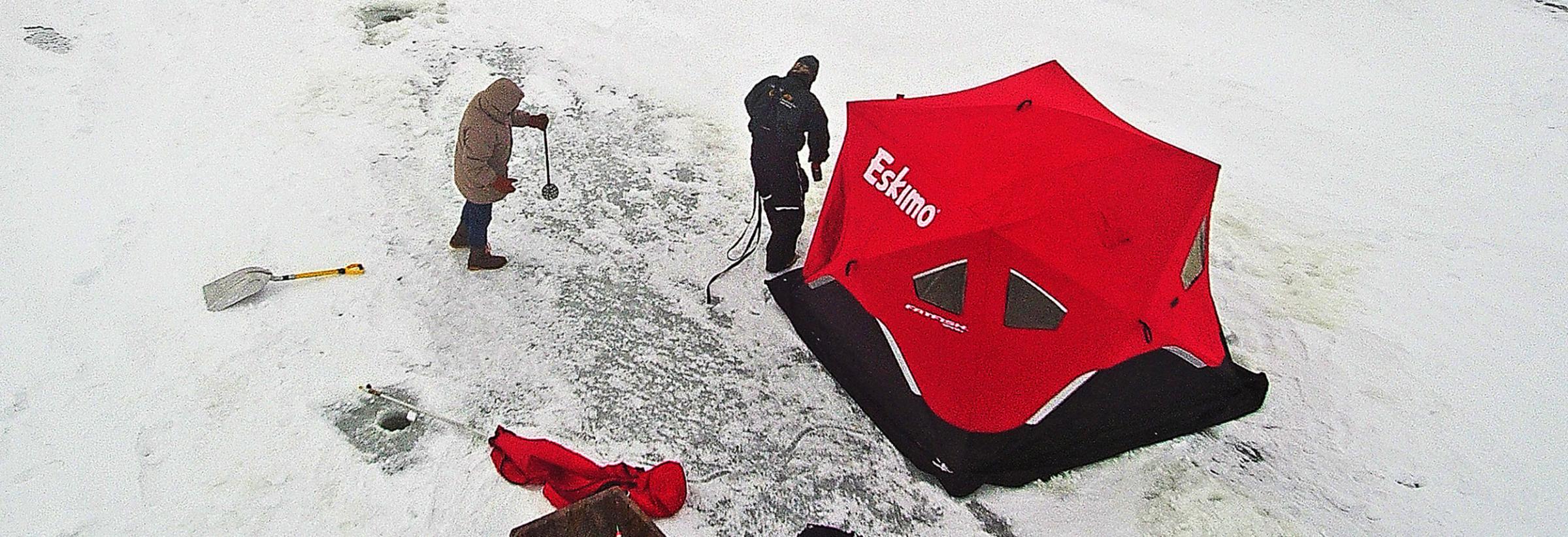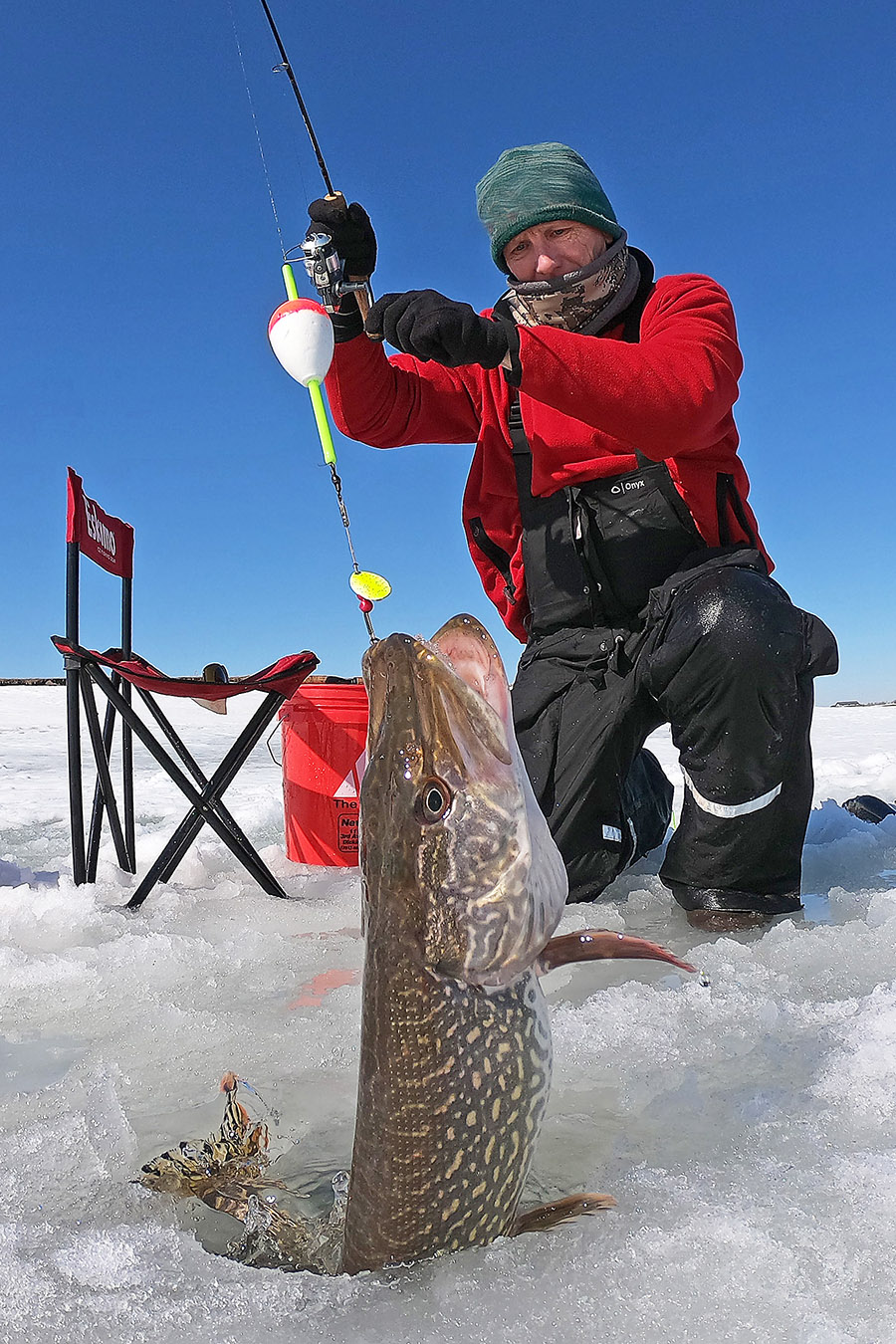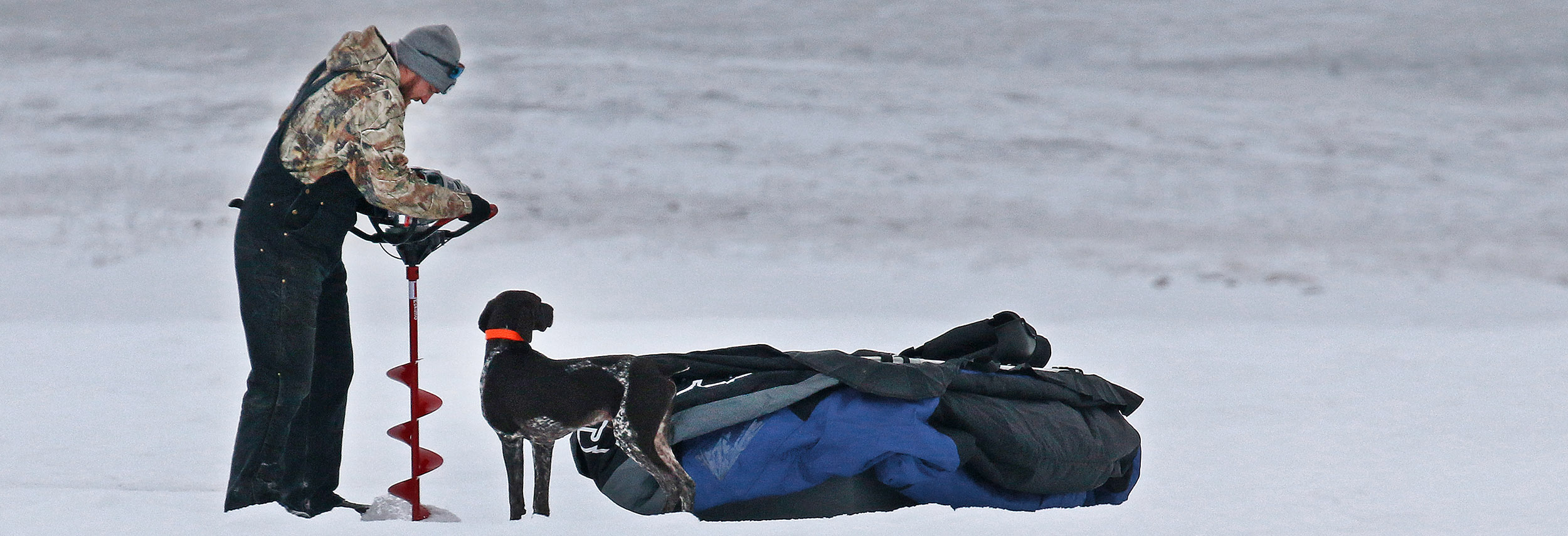
Lake Levels, Ice Fishing Opportunities on the Rise
There’s little certainty, save for the inevitable ice-up of your favorite lake, when it comes to ice fishing in North Dakota.
Last winter’s ice fishing season is a good example. Greg Power, Game and Fish Department fisheries chief, called it a tale of two seasons.
“It started well as we had pretty decent drive-on ice at the holidays, which is a big deal because it gets people out and about,” he said. “But that early participation ended pretty much statewide around January 10. Access went from good to lousy. And even if you could make it on your favorite lake, you needed an ice house to stay out of the weather.”

Fisheries biologists will tell you that with a little investigating, there remains some solid northern pike fishing across the landscape.
While it’s impossible to predict the influence weather will have on the upcoming ice fishing season, Game and Fish Department district fisheries supervisors have provided a list – an abbreviated list, considering there are more than 400 managed fishing waters on the landscape – of lakes expected to offer good fishing opportunities in the coming months if Mother Nature cooperates.
Power said ice anglers shouldn’t expect the perch fishing to be like it was, say, a decade ago. Yet, with a little investigating, there remains some solid northern pike fishing across the landscape.
“There is always Oahe, Devils Lake and Sakakawea, but the new kids on the block are nearly 60 newer walleye lakes that provide fishing opportunities on approximately 63,000 acres of newer water,” he said. “A lot of those lakes are primarily in the central part of North Dakota, and many have very healthy walleye populations.”
Last winter, tough conditions and declining lake levels, led to winterkill on 20 or so marginal waters. If that declining lake level trend would have continued, Power said 30 or more lakes would have experienced similar fallouts by next spring.
“If you compare today to last year at this time, the difference is night and day,” Power said. “In many of our newer lakes we lost 1-3 feet of water per year for the past three or four years. So, some of the lakes were down 6-8 feet from their highs.”
But things started to change starting in January 2019 when the snows came, providing decent runoff in spring.
“A lot of those lakes got a decent drink, then we had an exceptionally wet summer, a record-wet September in many of the counties, and maybe the wettest fall on record before it’s all said and done. That translates to most our lakes being at, or very near, their all-time highs, which is incredible compared to a year ago.”
The short-term outlook, thanks to an abundance of precipitation, is that far fewer waters will likely be lost to winterkill this winter compared to last.
Rising lake levels will also increase productivity and provide spawning habitat in recently flooded vegetation. These benefits aren’t short-lived and will benefit waters years down the road.
“Fish need water, so all species will benefit, but the fish that will certainly profit from this flooded vegetation are pike and perch,” Power said. “Looking in my crystal ball, I’m guessing we won’t need to stock a whole lot of pike next year. The next couple of years, we should have a lot fish, and given the growth rates we’re seeing in these prairie lakes, that means even more fishing opportunities in just a couple years down the road.”
Recounting the Darkhouse Spearfishing Season
Of the roughly 4,300 people who registered with the North Dakota Game and Fish Department to darkhouse spearfish last winter, more than 3,100 participated in what amounted to an abbreviated season, harvesting nearly 18,000 pike.
Greg Power, Department fisheries chief, said weather and access for the first half of the 2018-19 darkhouse season were favorable for spearing, but by mid-January extreme cold and above normal snowfall greatly reduced participation and effort.
The first darkhouse spearfishing season in North Dakota was held the winter 2001-02. Participation (3,717 participants) and number of pike harvested (28,138 pike) were highest in winter 2017-18.
According to a Game and Fish Department survey, respondents indicated spearing on 81 waters in the state last winter, down from 104 waters in 2017-18. Power said for the third year in a row, Devils Lake was the top water in terms of pike harvested in 2018-19.
In 2012-13, most waters in the state for the first time were opened to darkhouse spearfishing. North Dakota’s darkhouse season opens whenever ice-up occurs and all individuals who participate must register with the North Dakota Game and Fish Department prior to participating.
Free Ice Fishing
North Dakota’s free ice fishing weekend is December 28-29.
Resident anglers may fish that weekend without a license. All other ice fishing regulations apply.
Those interested in darkhouse spearfishing that weekend must register with the North Dakota Game and Fish Department prior to participating. Registration is available on the Department’s website, gf.nd.gov, or through any Game and Fish office. Legal fish are northern pike and nongame species.

An angler, with the help of his watchful bird dog, drills a hole in one of the hundreds of lakes scattered across North Dakota’s landscape.
District Reports
Southwest Fisheries District
Jeff Hendrickson, district fisheries supervisor, Dickinson
- Dickinson Reservoir (Stark County) – Good number of walleye up to 4 pounds, good number of bluegill up to 1 pound, good number of perch up to 1 pound, some crappie up to a half-pound and catfish up to 24 pounds.
- Heart Butte Reservoir (Grant County) – An abundance of mostly small walleye, with some fish up to 6 pounds, catfish up to 10 pounds, pike up to 17 pounds, white bass up to 2 pounds, crappie up to 1 pound and smallmouth bass up to 3 pounds. Good number of perch up to 1 pound and some bluegill up to a half-pound.
- Indian Creek Dam (Hettinger County) – Good number of walleye up to 8 pounds, abundant small perch, with some up to a half-pound, fair number of bluegill up to 1 pound, some smallmouth bass up to 2 pounds and largemouth bass up to 1 pound.
- Larson Lake (Hettinger County) – Adult perch stocked in spring 2019. Good number of perch up to three-quarters of a pound.
- Odland Dam (Golden Valley County – Abundant perch up to three-quarters of a pound, some bluegill up to three-quarters of a pound and walleye up to 2 pounds.
- North Lemmon Lake (Adams County) – Rainbow trout stocked annually. Some brown trout up to 2 pounds, abundant small perch, fair number of bluegill, with some up to three-quarters of a pound, fair number of largemouth bass, mostly 1-4 pounds, and a good number of walleye, mostly 3-10 pounds.
Northwest Fisheries District
Aaron Slominski, fisheries biologist, Williston
- Blacktail Dam (Williams County) – Good numbers of walleye and pike, with some bigger fish. Abundant small perch and bluegill, with some bigger bluegill in low numbers, and a low number of smallmouth bass.
- Northgate Dam (Adams County) – Good populations of walleye, bluegill and crappie. Stocked annually with rainbow trout, with some nice-sized, carry-over trout. Decent largemouth bass population.
- Trenton Lake (Williams County) – Good crappie population. Decent number of walleye, pike and catfish.
North Central Fisheries District
Jason Lee, district fisheries supervisor, Riverdale
- Antelope Lake (Pierce County) – Nice-sized perch abundant. Good number of walleye ranging from 16-26 inches.
- Clear Lake (Pierce County) – Good number of walleye from 14-27 inches.
- Cottonwood Lake (McHenry County) – Decent number of pike and a good number of 14- to 26-inch walleye.
- Hinsz Lake (Sheridan County) – Good number of 14- to 21-inch walleye.
- Lake Gertie (McLean County) – Good number of 22- to 29-inch pike.
- Lake Richard (Sheridan County) – Good number of 14- to 27-inch walleye.
- Long Lake (McLean County) – Good number of 19- to 32-inch pike.
- Makoti Lake (Ward County) – Abundant 24- to 34-inch pike.
- Rice Lake (Ward County) – Abundant pike, ranging from 18-37 inches.
- Scooby Lake (McLean County) – Newer fishery, with a good number of 14- to 18-inch walleye and some good-sized perch.
South Central Fisheries District
Paul Bailey, district fisheries supervisor, Bismarck.
- Alkaline Lake (Kidder County) – Walleye abundant. Fair pike numbers, with fish occasionally over 10 pounds. Large perch in low numbers.
- Braun Lake (Logan County) – Abundant walleye and small perch.
- Crimmins WPA (Burleigh County) – Walleye abundant and a low number of perch.
- Dollinger-Schnabel Lake (McIntosh County) – Fair number of perch up to 12 inches and small walleye abundant.
- Dry Lake (McIntosh County) – Excellent walleye and pike fishery, with a low number of large perch.
- Fish Creek Dam (Morton County) – Largemouth bass and rainbow trout abundant. Smallmouth bass, brown trout and crappie in lower numbers.
- Froelich Dam (Sioux County) – Walleye and northern pike abundant. Yellow perch, crappie, bluegill and largemouth bass present.
- Geier Lake (Kidder County) – Walleye abundant and a fair number of perch.
- Green Lake (McIntosh County) – Quality walleye and perch fishery, with a low number of pike.
- Harmon Lake (Morton County) – Largemouth bass, bluegill and crappie abundant. Rainbow trout and northern pike in lower numbers.
- Harr Lake (McIntosh County) – Abundant walleye and a low number of large yellow perch.
- Helen Lake (Kidder County) – Excellent northern pike fishery, with fish occasionally over 8 pounds. Perch present.
- Jasper Lake (Kidder County) – Walleye abundant and fish occasionally over 25 inches. Perch present.
- Kislingbury Lake (McIntosh County) – Walleye abundant and perch in low numbers.
- Lake Geneva (Kidder County) – Quality walleye and perch fishery.
- Lake Josephine (Kidder County) – Walleye abundant, with fish occasionally over 25 inches. Fair number of perch and a low number of northern pike.
- Logan Lake (Logan County) – Walleye abundant. Fair number of small perch.
- Long Alkaline Lake (Kidder County) – Abundant northern pike up to 4 pounds.
- Marvin Miller Lake (Logan County) – Excellent walleye fishery, with fish occasionally over 25 inches. Fair number of perch and a low number of northern pike.
- North Koenig Lake (Kidder County) – Small walleye abundant and perch present.
- Nygren Dam (Morton County) – Catchable-sized trout stocked in spring, small bluegill and 10- to 14-inch largemouth bass abundant.
- Rice Lake (Emmons County) – Walleye abundant and occasionally over 25 inches. Northern pike and perch in low numbers.
- Sibley Lake (Kidder County) – Small walleye abundant, but some fish over 20 inches. Multiple perch year-classes in good numbers.
- Wetzel Lake (Logan County) – Small northern pike abundant.
- Woodhouse Lake (Kidder County) – Walleye up to 28 inches abundant. Fair number of small perch.
Northeast Fisheries District
Randy Hiltner, district fisheries supervisor, and Todd Caspers, fisheries biologist, both Devils Lake
- Carpenter Lake (Rolette County) – Consistent pike producer, with lots of fish over 25 inches. Recent walleye stockings have been successful, with fish now up to 15 inches.
- Goose Lake (Wells County) – Good number of keeper-sized walleye, with some larger fish. Lower density pike population, with some larger fish.
- Homme Dam (Walsh County) – Perch and crappie common and should provide some action for winter anglers.
- Hurdsfield-Tuffy Lake (Wells County) – Walleye abundant, with a good number ranging from 15-20 inches.
- Island Lake (Rolette County) – Pike over 24 inches are abundant.
- Lake Coe (Eddy County) – Good number of walleye. Fish of all sizes available.
- Lake Laretta (Nelson County) – Good walleye population, with a decent number over 20 inches. Fair number of pike.
- North Lake Washington (Eddy County) – Good number of walleye, with fish up to 21 inches.
- Red Willow Lake (Griggs County) – Nice walleye population, with quite a few around 20 inches. Some bluegill up to 10 inches, but most smaller.
- Sibley Lake (Griggs County) – Supports a decent number of pike over 30 inches.
- Silver Lake WMA (Wells County) – Good number of 15- to 20-inch walleye. Decent number of keeper-sized perch.
- Wood Lake (Benson County) – Lots of bluegill, with the average length about 7 inches. Decent walleye and pike populations.
Devils Lake
- Walleye – Walleye fishing this winter will likely be a mixed bag, as many of the fish will likely be 15 inches or less. The number of walleyes from 15 to 20 inches is below average due to lower reproductive success from 2013 to 2015, so anglers will have to put in more time to catch fish in that size range. The number of walleyes over 20 inches should be about average.
- Northern pike – Pike should provide ample opportunities for anglers. Pike are still relatively abundant and tend to be good-sized, with most between about 24-32 inches. Pike are underutilized at Devils Lake, so anglers should not be shy about keeping a limit.
- Yellow perch – Perch fishing will likely be slower than typical again this winter. The number of catchable-sized perch is still below average. Many perch are about 9 inches or so, but there are larger fish.
- White bass – White bass are not a traditional target of ice anglers, as they tend to not bite especially well during winter. Even so, there are currently record high numbers of bass that are about 14 inches long in the lake.
Lake Irvine
- Walleye – Fishing may be a little slower than usual as walleye abundance seems a bit below average. However, fishing should still be good and most of the walleye will be between 14-20 inches.
- Northern pike – Pike are abundant, so ice fishing should be good. Most pike are medium-sized, but there are some larger fish as well. Pike in Lake Irvine are underutilized, so anglers should not be shy about keeping a limit. In fact, the pike seem to be too abundant, as their body condition, or plumpness, is relatively low. Keeping pike would be beneficial to the population as it may help reduce competition for food.
- Yellow perch – Perch numbers are typically low, but the few caught tend to be big.
Stump Lake
- Walleye – Winter anglers should have good luck with walleye, as their numbers are a bit above average and there are a variety of sizes available.
- Northern pike – Pike fishing should be decent. Pike numbers in Stump Lake are not as good as other lakes in the Devils Lake system, but they tend to be larger fish.
- Yellow perch – Perch fishing might be slower than typical, as their numbers appear to be lower than usual. Most perch are about 8 inches long, but there are larger fish present.
Southeast Fisheries District
Brandon Kratz, district fisheries supervisor, Jamestown
- Barnes Lake (Stutsman County) – Good walleye and pike populations. Fishing is typically the best in the morning at first light as the lake is typically clear.
- Elm Lake (Richland County) – Walleye population continues to expand, with many sizes available. Sampling efforts in 2019 yielded the highest walleye catch-rate in the lake’s history, with walleye averaging 17 inches. Pike and crappie also present.
- Fox Lake (Barnes County) – Each year anglers experience good walleye and perch fishing, particularly at first- and last-ice.
- Island Lake (Barnes County) – High density walleye population, with fish over 25 inches quite common. Over the last several years, the perch population has increased, providing additional angling opportunities.
- Kee Lake (Barnes County) – Great opportunity for anglers who like a diversity of fish species. Contains a healthy population of walleye, pike and perch. While pike tend to run less than 28 inches, the average length of walleye sampled in 2019 was 20 inches, with some decent perch available.
- Kraft Slough (Sargent County) – Abundant walleye, with fish averaging 20 inches. Opportunity for good perch fishing also exists.
- Moon Lake (Barnes County) – High density perch population, though sizes tend to be small, anglers can expect lots of action. Large walleye and smallmouth bass also found in fair numbers, along with the occasional brown trout.
- North Eckelson (Barnes County) – High density perch population. Though the average size tends to be about 7 inches, larger fish present.
- Ole Breum Lake (Sargent County) – Crappie, perch, walleye and pike exist in this lake and provide the potential to produce some good ice fishing action. The north and south basin have reconnected due to above average precipitation in 2019.
- Trautman Slough (Stutsman County) – Robust walleye population, with big numbers of eater-sized fish. Sampling efforts in 2019 suggests the perch population is expanding.
- Twin Lake (LaMoure County) – Excellent walleye population, with fish of all sizes including some trophies. Good pike numbers, with fish over 10 pounds.
